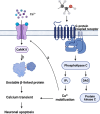An overview of current advances in perinatal alcohol exposure and pathogenesis of fetal alcohol spectrum disorders
- PMID: 38643092
- PMCID: PMC11031898
- DOI: 10.1186/s11689-024-09537-w
An overview of current advances in perinatal alcohol exposure and pathogenesis of fetal alcohol spectrum disorders
Abstract
The adverse use of alcohol is a serious global public health problem. Maternal alcohol consumption during pregnancy usually causes prenatal alcohol exposure (PAE) in the developing fetus, leading to a spectrum of disorders known as fetal alcohol spectrum disorders (FASD) and even fetal alcohol syndrome (FAS) throughout the lifelong sufferers. The prevalence of FASD is approximately 7.7 per 1,000 worldwide, and is even higher in developed regions. Generally, Ethanol in alcoholic beverages can impair embryonic neurological development through multiple pathways leading to FASD. Among them, the leading mechanism of FASDs is attributed to ethanol-induced neuroinflammatory damage to the central nervous system (CNS). Although the underlying molecular mechanisms remain unclear, the remaining multiple pathological mechanisms is likely due to the neurotoxic damage of ethanol and the resultant neuronal loss. Regardless of the molecular pathway, the ultimate outcome of the developing CNS exposed to ethanol is almost always the destruction and apoptosis of neurons, which leads to the reduction of neurons and further the development of FASD. In this review, we systematically summarize the current research progress on the pathogenesis of FASD, which hopefully provides new insights into differential early diagnosis, treatment and prevention for patents with FASD.
Keywords: Alcohol spectrum disorder; Fetal alcohol syndrome; Neuroinflammation; Neurotoxicity; Pathogenesis; Prenatal alcohol exposure.
© 2024. The Author(s).
Conflict of interest statement
The authors declare no competing interests.
Figures




Similar articles
-
Oral and written communication skills of adolescents with prenatal alcohol exposure (PAE) compared with those with no/low PAE: A systematic review.Int J Lang Commun Disord. 2021 Jul;56(4):694-718. doi: 10.1111/1460-6984.12644. Epub 2021 Jun 16. Int J Lang Commun Disord. 2021. PMID: 34137136 Free PMC article.
-
The Universal and Primary Prevention of Foetal Alcohol Spectrum Disorders (FASD): A Systematic Review.J Prev (2022). 2022 Jun;43(3):297-316. doi: 10.1007/s10935-021-00658-9. Epub 2022 Feb 5. J Prev (2022). 2022. PMID: 35286547 Free PMC article.
-
Beyond the Brain: The Physical Health and Whole-Body Impact of Fetal Alcohol Spectrum Disorders.Alcohol Res. 2025 Jun 12;45(1):05. doi: 10.35946/arcr.v45.1.05. eCollection 2025. Alcohol Res. 2025. PMID: 40525081 Free PMC article. Review.
-
Global Prevalence of Fetal Alcohol Spectrum Disorder Among Children and Youth: A Systematic Review and Meta-analysis.JAMA Pediatr. 2017 Oct 1;171(10):948-956. doi: 10.1001/jamapediatrics.2017.1919. JAMA Pediatr. 2017. PMID: 28828483 Free PMC article.
-
A systematic review of prevention interventions to reduce prenatal alcohol exposure and fetal alcohol spectrum disorder in indigenous communities.BMC Public Health. 2018 Nov 3;18(1):1227. doi: 10.1186/s12889-018-6139-5. BMC Public Health. 2018. PMID: 30390661 Free PMC article.
References
Publication types
MeSH terms
Substances
Grants and funding
LinkOut - more resources
Full Text Sources
Medical
Research Materials
Miscellaneous

